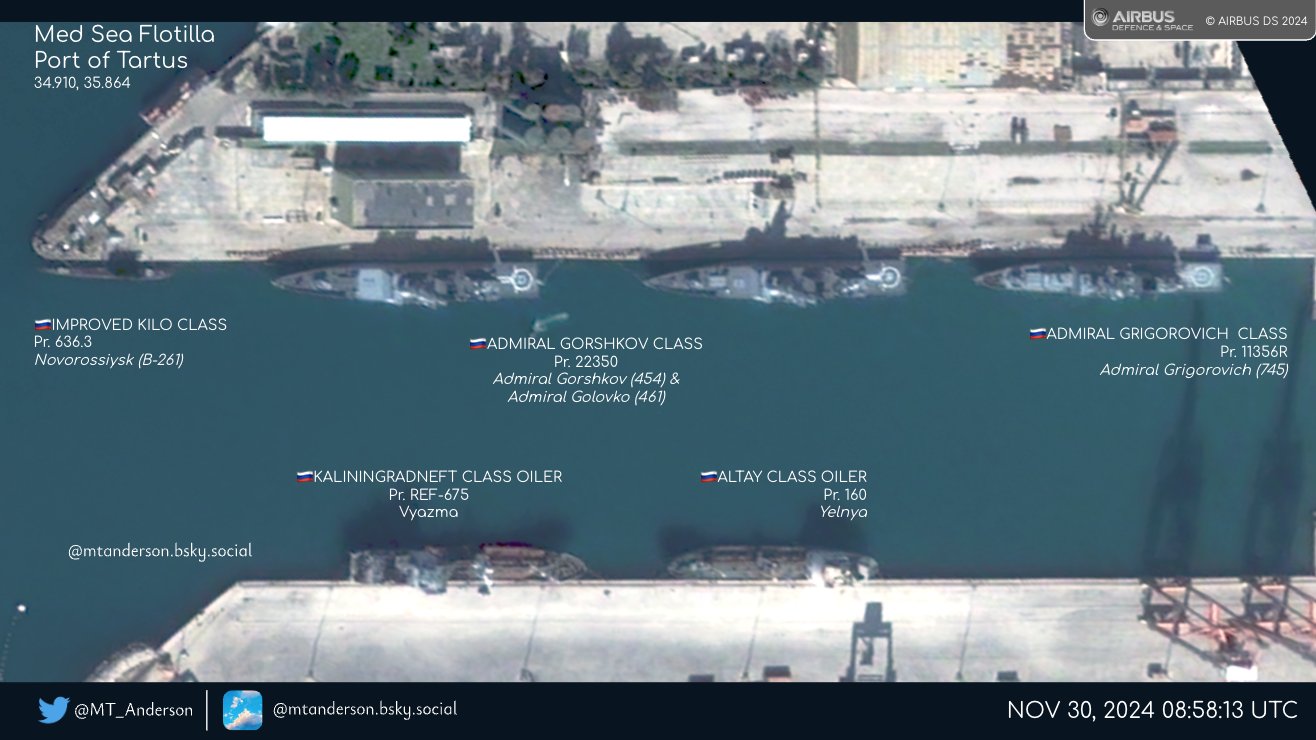Russia has begun evacuating critical naval assets from its base in Tartus, western Syria, as opposition forces make significant advances towards the Syrian capital of Damascus, putting President Bashar al-Assad’s regime under increasing pressure, The Telegraph and Naval News report.
On 2 December 2024, Russia’s auxiliary ship Yelnya, a key refueling vessel for the Russian military, was seen leaving Tartus, according to Naval News. Satellite imagery showed on 3 December that all major Russian warships based in Tartus – three missile frigates, a diesel-electric submarine, and two support ships – had departed the port and entered the Mediterranean.
This marked the first visible sign that Russia may be pulling valuable military assets out of Syria, as the Assad regime finds itself increasingly on the defensive.
“Certainly it appears likely that Russian warships are leaving the once safe port. It is expected that the warships will sail from the Mediterranean to the Baltic. Possibly they will seek temporary safe harbour in Algeria or Libya on the way,” H.I.Sutton says in his Naval News article.

Tartus: A key Russian strategic asset
Tartus, a Syrian port on the esatern Mediterranean coast, has long been a critical Russian naval base, providing Moscow with a vital foothold in the region. Russia has maintained its presence there since 1971, although the base fell into relative disuse following the collapse of the Soviet Union. Since the outbreak of the Syrian civil war in 2012, however, its strategic value has only increased, particularly after Russia’s full-scale invasion of Ukraine in 2022. Before the invasion, Russia had already reinforced its Tartus presence to counter NATO, particularly US aircraft carriers in the Mediterranean, and to support naval operations in the Black Sea, Naval News noted.
The Telegraph notes that the Tartus base has also served as a staging point for warships intending to join Russia’s Black Sea Fleet, though many ships were blocked by Türkiye from entering the Black Sea, after Russia started its full-scale invasion of Ukraine. Despite efforts to maintain a naval presence in the Mediterranean, Russia has struggled to keep up with its desired level of force there. The departure of its naval assets from Tartus could indicate that Russia is anticipating more serious threats to the base, as opposition forces close in on Damascus, threatening to cut the Russian coastal bases from the rest of the country.
Consequences
The withdrawal of Russian naval assets from Tartus could have far-reaching implications. According to Naval News, the fleet stationed at Tartus currently includes two Gorshkov-class frigates, a Grigorovich-class frigate, and an Improved-Kilo-class submarine, along with several auxiliary vessels.
The departure of Yelnya, in particular, is considered a significant move, as it is one of the key ships maintaining Russia’s naval operations in the region.
The Telegraph notes that the only realistic way for the Kremlin to replace the shore infrastructure in Tartus is by regaining access to the Mediterranean through the Bosporus, which Türkiye has closed under the Montreux Convention as long as Russia’s Black Sea Fleet is involved in the war against Ukraine.
“But there’s almost no prospect of that happening while the war in Ukraine still rages. Russian president Vladimir Putin may soon face an unhappy choice: keep fighting in Ukraine but lose influence in the Mediterranean region; or sue for peace in Ukraine and open up access from the Black Sea to the Med,” The Telegraph says.
Related:
- US Army Europe Commander: Putin risks losing naval resources in three different regions simultaneously
- Russians retreat from Hama and Homs amid Syrian opposition offensive, Ukrainian intel says
- Russian general Sergey Kisel dismissed from Syrian command, Ukraine’s intelligence says
- The logic of Ukraine’s first strike on Russia’s Caspian Sea Flotilla
- UK intel: Russia’s OKEAN-24 naval drill figures likely exaggerated
- Russian propaganda falsely claims Ukrainian involvement in terrorist training in Syria







